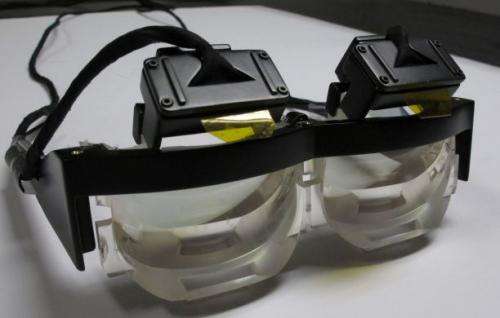Beyond Google Glass: Researcher looks to the future

(Phys.org) —A wearable display being developed by UA optical scientist Hong Hua could have capabilities even more advanced than those of the recently unveiled Google Glass, a pair of glasses with smartphone capabilities.
University of Arizona associate professor of optical sciences Hong Hua is developing technology that could make a wearable display that is lighter, easier to use and has finer and more varied capabilities than the recently rolled-out Google Glass.
Imagine strolling down the street wearing a new pair of glasses – but these are no ordinary shades. A miniscule computer lodged in the frame projects text onto the lenses before your eyes, reflecting the light so that the information appears to be at arm's distance away from you, or a little farther, but only you can read it. You can control the functions of the device by voice, generate a map giving you directions, read text messages and take photographs and video.
Your glasses can do essentially everything a smartphone can do, all in a wearable, lightweight, transparent display.
The recently unveiled Google Glass product can do all this, but Hua is working to take the technology a step beyond even those capabilities.
"Google Glass is not intended for applications that require a large field of view and high resolution," Hua said. She said the device she is developing will have a much larger field of view to create a sense of a large virtual display. Her system can be configured to display information in both eyes; it has the capability of creating the sense that you are seeing three-dimensional space; and it will display true high-definition images.
"Google Glass is also not intended for 3-D capability and not optimal for applications in virtual and augmented reality," Hua added.
Hua works with augmented reality, or AR, technology that she said is related to virtual reality but still allows the user to interact with the real world.
"For virtual reality you wear a display and you are totally immersed into a computer generated image so you don't see the outside reality. For augmented reality you are not going to generate the entire view digitally. You are going to use the surrounding environment and can pick and select what information you want to display."
"If you wear this device on the street, of course you want to be able to see the outside world," Hua said, which is where the augmented reality technology comes into play. "You could use this type of device to superpose digital information on top of your real world to assist your daily activity."
For example, let's say that at some point during your walk you feel a grumble in your stomach and begin to scan the storefronts in search of a place to grab lunch. Through your glasses, translucent lettering would pop up in front of you, overlaying the restaurant across the street with relevant information such as menu items and prices.
Developing a device such as this, Hua said, requires integrating a variety of technologies including microdisplays, optical technology, sensor technology, electronics and computing.
"You need to allow the person to see the outside world without any obstruction and the device needs to be as lightweight and convenient as possible," she said.
The micro-display needs to be bright enough for people to use outside, and the image needs to be in high-resolution to provide detailed maps or text messages, she added.
Hua is creating freeform optical surfaces, which are different from conventional optical surfaces in that they are highly variable in their surface shape, with some areas more curved than others. This emerging optical technology allows her to design an eyepiece for wearable displays with a very compact form factor, for example shaped like sporting sunglasses.
"Traditionally we wouldn't be able to make an eyepiece in such a compact form," Hua said. "This can be achieved with freeform surfaces."
Three-dimensional AR displays such as the one Hua is developing have a variety of promising applications, Hua said, from assisting users with directions to video gaming to military training.
"For example, we can build an augmented environment where the soldier could see the battlefield through this type of glass," Hua said. "It could be used for training."
The device has medical applications, too. Hua collaborates with UA assistant professor of neurology Katalin Scherer and Cass Faux, a UA clinical assistant professor of speech, language and hearing sciences, to make the glasses compatible for patients with amyotrophic lateral sclerosis, or ALS, a neurodegenerative disease that causes patients slowly to lose control over their muscles.
"Eventually the only thing they can move are their eyes," Hua said. "The eye movements become their only means to communicate with the outside world."
"We are developing one of these systems which has the capability to monitor eye movements," she said. "So the patient can wear this device and see a virtual screen in front of her and then move her eyes to type information telling the caregiver what she wants or needs."
The device would be a leap beyond the current system used for ALS patients, in which patients use a large computer screen and mounted camera to capture their eye movements. "Now we are trying to shrink that whole package down to something very portable," Hua said.
Hua believes the device can be used for other medical applications, for example in surgery, where surgeons could see information about the location of organs or other body parts through the glasses while operating.
"The vision in the future is that your phone is a pair of glasses that you wear and you can dial in using your voice and see your screen pop up in front of you, generated through the glass," Hong said. "And then you start to interact with it with your eye gaze, voice or gesture."
Provided by University of Arizona





















